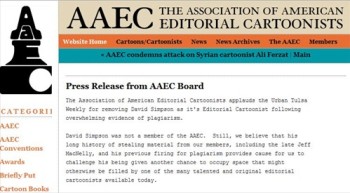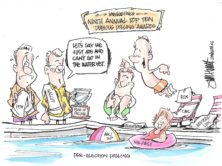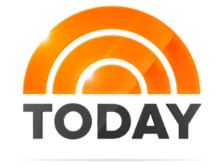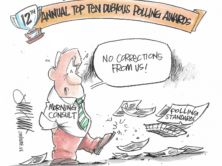
(Credit: association of american editorial cartoonists)
Editors Weblog questioned if there should be an “ethical code for cartoonists” in light of Urban Tulsa Weekly cartoonist David Simpson and Columbia Dispatch’s Jeff Stahler both being accused of plagiarism. Both resigned over the charges.
In response, the Association of American Cartoonists is considering creating a cartoonists code of ethics, Poynter reported The group has no “ethical guidelines or training programs” right now. The group’s president, John Cole, is quoted as saying that the group is questioning “Is it the place of the Editorial Cartoonists to police or call out obvious examples or examples that its members perceive?” Cole noted that the group would have to also decide what is plagiarism in cartooning.
We wrote to Cole asking if the group has any plans to create that code of ethics. He told us by e-mail that the organization’s Sept. 2009 bylaw, Article XIX, addresses plagiarism. That article “states that association members agree never to engage in plagiarism, and empowers the board of directors to ‘permanently or temporarily suspend’ any member who appropriates ‘another creator’s work as one’s own,'” he told us by e-mail.
According to Editors Weblog, the Association of American Editorial Cartoonists “has to decide how to react to Stahler’s case.” In a Nov. 8 press release, the group said it “applauds the Urban Tulsa Weekly for removing David Simpson” after the plagiarism charges, noting that Simpson didn’t belong to the AAEC. John Cole told iMediaEthics by e-mail that the group hasn’t any current plans to issue a similar statement about the accusations against Stahler, but noted that the group’s “board of directors is still discussing the issue at large.”
According to the Washington Post, Stahler resigned Dec. 10 after “some in the comics community” noted that his Dec. 5 cartoon was “strikingly similar” to a 2009 David Sipress New Yorker cartoon. Stahler was suspended Dec. 6. The New Yorker’s cartoon editor, Robert Mankoff, seemingly defended Stahler at first, suggesting that Stahler “came up with the idea completely independently” or unintentionally lifted the cartoon after seeing the idea and forgetting about the original cartoon. Later, he changed tack and indicated that Stahler’s work had “too many coincidences.”
The Washington Post noted that satirist Andy Borowitz pointed to similarities between a satirical headline he wrote and a subsequent Stahler cartoon” earlier this year, but the Dispatch dismissed it as “coincidence.”
In that May incident, Poynter’s Jim Romenesko wrote that Borowitz questioned a cartoon of Stahler’s that mirrored one of his posts. The Stahler cartoon was published three days after Borowitz’s May 19 post titled “New Study Finds iPad is Cure for Adultery; Owners ‘Stop Noticing Other People Altogether’”
We asked the association’s Cole if plagiarism has become an issue for cartoonists recently or if it’s just the timing of two sets of accusations against cartoonists that has prompted this attention to cartoon plagiarism. He told us by e-mail:
“Plagiarism was and is as much a problem for cartoonists as it is for other folks working in the media, I think. Certainly, two high-profile cases like this will throw a harsh light on editorial cartooning in general. But the same could be said of the reporting side of the business when the fabrications of Jayson Blair, Stephen Glass, Jack Kelly and others came to light. These are the hard cases; the vast majority of cartoonists, writers, photographers and designers are honest and conduct themselves in a professional manner.”
We also asked Cole what other ethical issues cartoonists face. Cole responded via e-mail:
“We work in a craft that, generally speaking, deals in visual and graphic images and metaphors that are quickly recognizable to readers. The daily challenge is to use these devices (or not) in a way that’s as authentic and original as possible. The ideas, sensibilities and images in a cartoon should represent those of the person who signed it.”







Comments Terms and Conditions